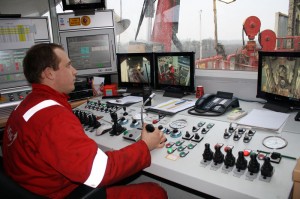Shell, CNPC look to automated well manufacturing for step-change

The time is ripe for a step-change in the high-density segment of the drilling business, and two giants in the energy industry – Shell and China National Petroleum Corp (CNPC) – recently took a leap forward by signing a joint venture (JV) agreement to develop a highly automated well manufacturing system for onshore drilling. “As drilling contractors say, most rigs today are like Swiss Army knives – they can do many, many things,” Peter Sharpe, Shell executive VP wells, said at a media briefing in Houston on 21 July. “What we’re looking to do is build machinery that will only do one standardized task in the most efficient way, and it will do no additional tasks, and it will do that 1,000, 2,000, 5,000, 10,000 times in a particular field.”
Under this vision, rather than using one rig to drill each well, multiple machines will be used to drill and complete different phases of the well in a factory-like system, with multiple wells being drilled simultaneously with minimal human input.
Shell and CNPC are currently working to establish the legal entity for the JV, which will be Singapore-based, and to design and build the equipment and systems that will do the drilling and completion. Automation will be a key aspect of the systems, and Shell has already developed the algorithms that will work in tandem with the programmable logic controls (PLCs), rig equipment and downhole tools to optimize vibrations, ROP and other downhole parameters to directionally steer the wells to target.
“The control system that we’ve developed at the moment is really replacing the directional driller, MWD operator, driller, mud engineer. We believe that actually for these very repeatable, low-cost, simple wells that we can do this much more predictably with a series of algorithms and PLCs,” Mr Sharpe said.
The well manufacturing system is still under development; however, one component of the system – ScadaDrill – is already being used in the Netherlands and in North America in the Marcellus and Groundbirch. This autonomous drilling technology can be retrofitted onto existing rigs fairly easily, and Shell has already seen a 70% improvement in ROP where the technology is used, according to Mr Sharpe.
“Generation 1 (of ScadaDrill) has demonstrated itself to offer a real opportunity. We’re still developing things like a system that will monitor drilling fluids in real time and decide when to treat them. What we’ve realized already is that measuring the mud properties twice a day and then throwing a bunch of chemicals in is a really inefficient way to do it. … There’s a much more tailored way to treat the drilling fluids while you’re drilling to both ensure you’ve got uniform properties but also minimize the use of chemicals,” he said.
The JV will source its equipment primarily from CNPC subsidiaries, with manufacturing capabilities worldwide, and will use both Shell and CNPC’s procurement capacities. Actual manufacturing of equipment may start as early as the end of this year, with commencement of operations targeted for early 2013, according to Mr Sharpe.
Coalbed methane, heavy oil and some shale gas plays are thought to be a good fit for this type of well manufacturing approach, but Mr Sharpe stressed that “it’s not a universal solution for everything we do in the tight-gas business.” It’s about scale, duration and standardized well designs and applying a “well manufacturing mentality” where it makes sense economically.
“I think we’re good at what we do now, and I think what we’re doing with this well manufacturing JV will take us to a different level,” Mr Sharpe said.




